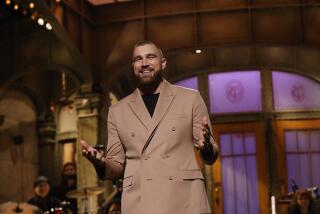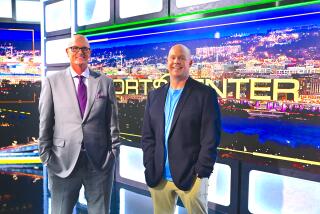ESPN’s efforts to reinvent SportsCenter take a page from late-night comedy
- Share via
Reporting from BRISTOL, Conn. — Visitors who enter the 194,000-square-foot digital studio facility on the campus of ESPN are greeted by touch screens that can access every commercial in the long-running “This Is SportsCenter” campaign.
The display honors the flagship sports highlights program that has been a vital part of the Walt Disney-owned media company since it launched in 1979. Although “NFL Monday Night Football,” the NBA, Wimbledon and U.S. Open tennis and Major League Baseball are among the lures to get cable and satellite companies to pay substantial fees to carry ESPN channels, “SportsCenter” is the connective tissue that keeps fans tuned in every day between those live events.
But even one of the longest running and most recognizable TV institutions isn’t immune to the rapid changes in the TV marketplace, in which more viewers — especially younger ones — are going online for video content.
See more of Entertainment’s top stories on Facebook >>
The game highlights seen for “SportsCenter” are consumed by a growing number of fans online on computers and mobile devices. Many of those fans go to ESPN.com, as the “SportsCenter” production team produces a highlight for every game whether it makes it onto the show or not.
Those shifting habits have prompted ESPN to start reinventing its signature show, most notably with a new late-night version built around the quirky personality of Scott Van Pelt, a veteran of the channel who developed into a highly opinionated host on ESPN Radio.
You need personalities to differentiate [the highlight grind] in each part of the day.
— Lee Berke, a sports TV consultant
“They are trying to pull away from the highlight grind because everybody has access to those highlights instantaneously,” said Lee Berke, a sports TV consultant. “You need personalities to differentiate it in each part of the day.”
Van Pelt’s solo-hosted “SportsCenter,” which airs at midnight Eastern and 9 p.m. Pacific, was launched in September and has lifted ESPN’s ratings in the hour 4% to an average of 744,000 viewers. Last month, ESPN set its sights on the early morning hours, replacing repeats of the 1 a.m. Eastern “SportsCenter” from Los Angeles with a live program, “SportsCenter: A.M.,” that uses a four-anchor format evocative of “Today” and “Good Morning America.”
The current moves come at a crucial time for ESPN. The sports behemoth remains the biggest contributor to Disney’s lucrative cable group, which had operating income of $6.8 billion for fiscal 2015. Nonetheless, Wall Street analysts have become obsessed with the impact of cord cutting on its future. ESPN has lost several million subscribers over the last few years as more viewers go without a cable or satellite connection.
During the most recent fiscal quarter, Disney’s media networks unit, which includes ESPN and other television assets, posted a 6% decline in operating income.
Disney Chairman Robert Iger acknowledged at the company’s recent shareholders meeting that ESPN would grow at a slower pace.
“We’re not in any way taking matters lightly in terms of what’s been said about ESPN,” Iger said. But he added that the network’s business is healthy, with more than 200 million people watching ESPN content across various platforms each month.
Reflecting the new environment, ESPN reduced its worldwide staffing 4% last year. Deals have begun to get its channels onto “over-the-top” Internet-delivered TV services such as Sling and Vue, available on Sony’s PlayStation, to reach the cord-cutting generation.
We’re not in any way taking matters lightly in terms of what’s been said about ESPN.
— Disney Chairman Robert Iger
But keeping “SportsCenter” relevant is necessary to maintain ESPN’s profitability while the cost of sports rights fees continues to rise. The company does not break out ad revenue, but an executive not authorized to comment publicly said the “SportsCenter” ad sales total for 2015 exceeded the 2014 figure of $707 million estimated by Kantar Media. ESPN produces 6,700 hours of “SportsCenter” a year.
“They are very dependent on it,” Berke said. “They are paying more for sports properties. ‘SportsCenter’ is far less expensive for them to put on the air as long as they generate viewership and a decent rating for advertisers.”
Rob King has been looking to enhance and expand the franchise since he was named senior vice president of “SportsCenter” and news for ESPN in 2014. He attacked late night first, King said, because the departures of long-running hosts David Letterman and Jon Stewart meant their fans might be searching for something new.
“It led us to think the viewers available after the 11 o’clock ‘SportsCenter’ are making the decision on who they want to hang out with,” King said. “Research showed that if we were going to do a show with any one person, Scott is the guy that people would want to spend time with.”
A former Washington TV personality turned golf reporter who joined ESPN in 2001, the 6-foot-6 Van Pelt is well known to “SportsCenter” viewers, having been part of the two-anchor teams on the 11 p.m. hour. (He’s the guy standing in line at the ESPN cafeteria who whispers “that was awesome” in the classic “This Is SportsCenter” spot in which Arnold Palmer mixes his own iced tea and lemonade.). His mandate at midnight still includes highlights, especially for West Coast games still in progress, but they are shown through what King calls “the prism of what Scott thinks is interesting.”
Van Pelt is not a firebrand like former ESPN stars Keith Olbermann and Bill Simmons, who agitated his bosses after he called for the NFL commissioner to resign (Simmons left last year for HBO). But Van Pelt regularly injects emotion and personal passion to his commentary, called “1 Big Thing.”
One night he showed a photo of his late father, an alcoholic, when discussing New York Yankees pitcher C.C. Sabathia’s announcement that he was headed to rehab.
More often, viewers are exposed to Van Pelt’s self-deprecating humor, including a recurring feature — “Where in the World Isn’t SVP?” — showing viewer-supplied photos on Twitter of people who sort of look like him. “It’s staggering how many white guys there are with these rectangular black glasses,” said Van Pelt, whose Twitter handle is @notthefakeSVP. “There must be 100 of them that are referees.”
His “Oh No!” segment picks embarrassing moments caught on video, from on-field blunders to Dr. Ben Carson’s botched stage entrance at a recent Republican primary debate.
Although ESPN’s coverage has always included odds making and point spreads in its football coverage, Van Pelt delves into sports gambling with the sophistication of someone who has bet both with his head and over it. He’s describes stadium crowds that cheer at the result of a coin flip as “my people.” His “Bad Beat” segment can break down the final seconds of an obscure college basketball contest to show how a sure bet to cover the point spread can go horribly wrong.
“I know what it is to have more on a game than you should,” said Van Pelt, 49, who regularly wagered during his days as a University of Maryland student. “I arrive at the microphone with a perspective that is informed.”
ESPN’s research shows that fans who go on its website after midnight were digging deep into box scores and game results, indicating that they were likely to be a receptive audience for what King euphemistically calls “predictive analysis” on Van Pelt’s show.
“They are either in fantasy leagues or have a friend in the desert,” he said.
King, who took over “SportsCenter” after running ESPN.com, is also aware that late-night shows no longer just live on TV. Just like the viral videos of late-night hosts Jimmy Fallon and others, Van Pelt’s titled segments are designed to live online long past the shelf life of most sports highlights — significant as ESPN’s digital ad sales approach $500 million in annual revenue.
Van Pelt knows his success is tied to how effectively he connects to viewers.
“The show is going to be framed from what I think matters, why it matters and my opinion of it,” he said. “If you think I’m full of … you’re not going to be interested.”
Follow @SteveBattaglio on Twitter
ALSO:
Jury awards Fox Sports’ Erin Andrews $55 million in nude video lawsuit
ESPN and Tencent team up to cover sports in China
ESPN says it will address Curt Schilling’s comments about Hillary Clinton and Donald Trump
ESPN, ABC channels launch on PlayStation streaming service
More to Read
From the Oscars to the Emmys.
Get the Envelope newsletter for exclusive awards season coverage, behind-the-scenes stories from the Envelope podcast and columnist Glenn Whipp’s must-read analysis.
You may occasionally receive promotional content from the Los Angeles Times.







